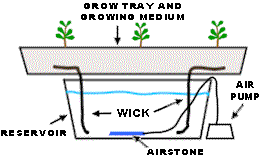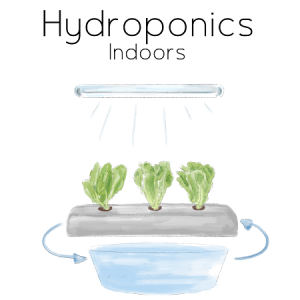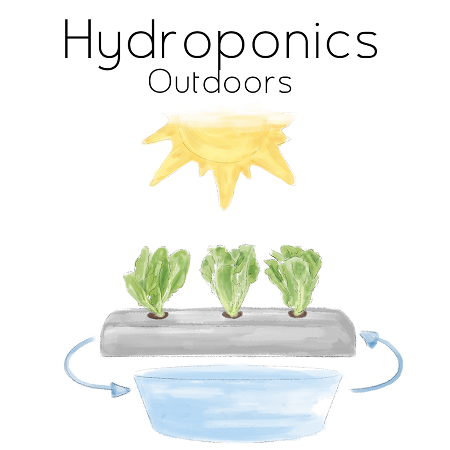What is Rockwool?
Many people will have seen Rockwool, or a very close relative of it without realizing. What was once used as insulation for roofing or building projects was found to be an effective growing medium for hydroponics when there was a slight change to its structure.
Rockwool comes under a couple of different names, and one of the common ones being “Stonewool.” This is man-made, and to do this, they take basalt rock, which is an old volcanic rock, and melt it at high temperatures along with limestone.
Once it reaches a molten lava stage, this is spun into fibers much like cotton candy. Once these fibers are made, they add a binder into the mix and compress the resulting material into a mat. From here, it will be cut into a variety of shapes and sizes that meets the needs of hydroponic growers.
Sizes you can often find are slabs, cubes, croutons, granulate blocks and starter plugs. These are found to retain moisture to almost ideal conditions, it will retain oxygen and because of the fine structure, it never impedes the growing of plants rooting systems. Rockwool can actually promote a strong vigorous growth.
What Can I Grow Using Rockwool?
There are all manner of plants and vegetables, which can be grown in Rockwool. While commercial growers use it for germinating lettuce before they transplant them to NFT systems, home growers can use larger Rockwool blocks for growing all manner of leafy greens, herbs, peppers, tomatoes and cucumbers among others.
Growers who use their system for cut flowers find that both Gerberas and Roses grow well when planted in Rockwool.
Once new growers see the benefits of Rockwool, they begin to look at how they can benefit from using it in their garden. For many, the uses do fall down to either germinating seeds, or when cloning new plants, however, larger blocks are more versatile than just using Rockwool starter plugs for this purpose.
No matter what the use, the properties of Rockwool make it an almost perfect growing medium for plants. In comparison to its size, it can hold a large amount of water. This makes it ideal in systems where there are dry periods, and growers don’t want their growing medium to dry out completely.
This feature also acts as a security measure in case there are power outages, or there is a pump or timer failure.
If water retention wasn’t a good enough reason, then the ability to hold almost 20% oxygen between the fibers is. This delivers lots of oxygen to the root zones and makes it hard to actually over water their plants.
Larger 4-inch cubes are used for the bigger plants we saw above, yet the plugs of around 1.5 inches are often used for germination and cloning.
Rockwool makes it easier for new growers, in what could be a stressful time. Using Rockwool, they can keep their seeds damp enough without them sitting in a waterlogged environment. When it comes to cloning, part of the old plant will be taken from another and planted so it can grow into a new plant all of its own.
This can be a more successful and cheaper way of growing plants for many growers because it will be an identical clone of the original plant, which was the donor.
For this method to be successful there does need to be lots of humidity around the cutting. If it dries out too much, then a plant will revert to self-preservation mode and stop trying to grow new roots.
Any method of growing needs to be in a sterile environment, and the way they manufacture Rockwool means it is 100% inert. The heating process it goes through during the manufacturing process means there is little chance of fungi or bacteria entering into Rockwool.
Steps in Using Rockwool for Planting Seeds
It may appear daunting when planting seeds for the first few times; however, it can be very straightforward and successful when using this growing medium.
Here are the steps to follow when planting seeds.
- Rockwool preparation – soak your cubes well in pH adjusted water. They should have a pH of 5.5 to 6.5.
- In the hole in the top of the plug, insert two seeds. Using a fine object such as a toothpick push the seeds toward the bottom of the hole.
- Pinch the top of the hole closed or cover with a small piece of Rockwool.
- Add all your starter plugs to a nursery tray and place a humidity done over the top. Keep the temperature around 70-80 degrees Fahrenheit.
- Check every couple of days and make sure the cubes are not drying out. Either water sparingly or mist them with a water bottle.
- Once you see your seeds sprouting, remove the plugs from under the dome and place them under your growing lights.
- Once you see a dominant seedling, trim back the smaller one to prevent growth. Never try to remove this smaller shoot as it can damage the shoots of the larger seedling.
- Once these reach between two or three inches in height, you can transplant them to your system. When doing so, there is no need to try to remove the starter plug; this can go directly into your growing medium of choice.
Steps for Propagation Using Rockwool in Hydroponics
Propagation of plants can be harder for new growers until they understand where they need to cut from the donor plant. However, the steps for using the Rockwool cubes are no harder than doing so when growing from seeds.
- Make sure your Rockwool cubes are soaked will in pH-adjusted water.
- Make sure to water your donor plant well the night before you begin propagation
- Take the main stem of the donor plant and cut 3 to 4 inches of leaf stem from as close as you can to the main stem of the plant. Be careful not to damage the node.
- Take the cut end and dip it into some rooting hormone
- Take the cutting and place it into your cube, but make sure it doesn’t start to emerge from the bottom.
- Take your nursery tray and half fill with vermiculite of perlite.
- Place the cubes on top of this growing medium.
- Close the moisture dome to lock in the moisture and maintain a temperature of around 80 degrees Fahrenheit.
- Once roots begin emerging, open the lid slightly and increase more the day after.
- Remove the dome completely a few days later once the first roots appear.
- Once roots are showing through the bottom of the cub, transplant to your system.
Preparing Rockwool for Use
When using Rockwool, it is important to prepare it before use. While there are other growing mediums, which are pH-neutral such as coco coir and clay pebbles (Hydroton), Rockwool has a naturally high pH of around eight.
This occurs because of the limestone that is mixed with the basalt during manufacturing. If you don’t make sure you adjust the medium before use, then this high pH will prevent plants being able to uptake these nutrients.
Plants prefer conditions that are more acidic, hence the adjustment of the pH before use.
The steps for doing so are easy, yet they can be a little time consuming, so allow yourself a few days before you need to use your new batch of Rockwool.
The first step is to soak your cubes in water, which is acidic. This will dissolve the lime, which forms during manufacture. Distilled water is the best option because you know what the pH will be. Water from the faucet can vary depending if you are in a soft or hard water area.
You should adjust the water so the pH drops to around 5.5. If it goes below five, then this can begin damaging the fibers. Once you do this, allow them to soak up this pH-adjusted water for 24-hours. If these blocks are for use in your system, then locate them in position and run your system without plants until your system pH stabilizes at around 5.5 to 6.0.
Things to Do, and What Not to Do With Rockwool
Using Rockwool can be straightforward, and this can be seen from the amount of growers, which use it. However, there are a few things you need to do, and some things you should to gain the full benefits of this growing medium.
Here we will look at all the things you do need to do:
Pre-soaking Rockwool
When you purchase this growing medium, it will feel very light, as it will be very dry. It is crucial to first wet it sufficiently before you use it. To know it is ready for use, you should submerge the medium in water that is balanced to a pH of 5.5 until there are no more bubbles emerging from the blocks.
By this submersion, the water can penetrate all the tiny pores and holes that are on the inside of the medium. While some growers soak for extended periods, it can be enough to be from seconds or minutes for the starter plugs, or several minutes for the larger 4-inch blocks. It is better to leave it as long as you can to be sure it is thoroughly soaked.
Once you have made this pre-soak, then you need to let it stand and drain. Water will flow and then stop, the medium will still be damp as the moisture only comes from the larger pores where it lets oxygen inside. This gives you the ideal water to oxygen ratio for your plants.
Before using for your plants, you should be sure to wet them with your nutrient solution. After the initial drain, the remaining nutrients will be directly available for your plants. Soaking with just water will weaken the nutrient concentration inside the blocks.
Never Unwrap Your Cubes
The larger blocks will come wrapped in a kind of plastic foil. This won’t let any light inside, and it is there for a reason. This has the same function as your other growing pots. Not only will it prevent air pruning by keeping the light out, it will keep the roots inside.
One other reason this covering needs to stay on the block is it helps prevent algae on the sides. In the case of slabs, these will be fully covered. Because you can’t fit these into buckets, you can soak them from the top with your nutrient solution, and after they have stood, you can make drainage holes on the underside.
Make Sure You Have Good Drainage
All plants will absorb more water than nutrients. You will have a buildup of these salts in your growing medium over time if you don’t allow for a full run-off. As your root zones are irrigated, this new solution pushes the previous slats closer to the bottom of the growing medium.
If there isn’t enough drainage or run-off to allow these salts to drain away, it will become unhealthy for your plants. You need to allow between 20 and 30% of the solution volume going in, and draining from the bottom as a maximum. This will help retain the ideal conditions in the plants rooting zone.
Reuse or Recycle Your Rockwool
When you are using horticultural Rockwool, you may read or hear myths, which say you can’t reuse it or recycle it safely after use.
You can in fact use the larger blocks again as long as you are sure there are no roots remaining. These will rot, but you can purchase enzymes that will help get rid of these, and after you do this, you can reuse them again for a different type of crop.
Rockwool in essence is a rock and it can be broken up and added to compost or added directly to soil garden beds. The only area you should be using Rockwool a second time is for starting your plants.
Here are a few things you should never do when growing with Rockwool:
Never Squeeze Rockwool
Because this growing medium retains so much fluid, new growers may be under the impression there is too much water in the block. Growers should never squeeze their blocks to remove excess water. Squeezing removes too much water as well as damaging the structure of the blocks.
The structure is already ideal for plant growth, so all it needs is wetting and letting it drain naturally before use.
Never Over Stack Your Pots with Rockwool
If your system irrigates from the bottom, you should be cautious of how tall your pots are. Water will never wick more than five or six inches, no matter how good the medium is at absorbing water. Gravity will prevent it from rising higher than this. If you are using a bottom feeding system, be sure the tops of your pots are no higher than this.
Top feeding systems are not as much of a problem because the solution waters from the top. This will fill all the fibers sufficiently before it comes to the time to drain.
Rockwool Usage Tips
There are a few things growers should understand before they begin using Rockwool for the first time.
Health Concerns When Using Rockwool
Because there is such a similarity with home insulation and Rockwool, many growers are led to believe it can be dangerous to inhale any dust or particles.
For any growing medium, it is advisable to wear a mask when handling these in their dry state. This can relieve any discomfort, as can wearing rubber gloves in case there is any skin irritation. The initial soaking should wash away any of these particles, and from that moment, the blocks should always be damp so the particles will never rise into the air.
Preventing Algae on Rockwool
Like any growing medium in a hydroponic system. A surface, which is moist and exposed to light, can be the ideal conditions for algae growth. Many growers know this all too well, and even if it doesn’t cause problems, it doesn’t look very nice.
To prevent this, they may cover the tops of their large Rockwool blocks with dark plastic to stop light hitting the damp surface. This can be the same for any area of your system where light gets to where your solution sits. Tanks, tubing and grow troughs being prime examples.





 The
water culture system is the simplest of all active hydroponic systems.
The platform that holds the plants is usually made of Styrofoam and
floats directly on the nutrient solution. An air pump supplies air to
the air stone that bubbles the nutrient solution and supplies oxygen to
the roots of the plants.
The
water culture system is the simplest of all active hydroponic systems.
The platform that holds the plants is usually made of Styrofoam and
floats directly on the nutrient solution. An air pump supplies air to
the air stone that bubbles the nutrient solution and supplies oxygen to
the roots of the plants.
 Drip
systems are probably the most widely used type of hydroponic system in
the world. Operation is simple, a timer controls a submersed pump. The
timer turns the pump on and nutrient solution is dripped onto the base
of each plant by a small drip line. In a Recovery Drip System the excess
nutrient solution that runs off is collected back in the reservoir for
re-use. The Non-Recovery System does not collect the run off.
Drip
systems are probably the most widely used type of hydroponic system in
the world. Operation is simple, a timer controls a submersed pump. The
timer turns the pump on and nutrient solution is dripped onto the base
of each plant by a small drip line. In a Recovery Drip System the excess
nutrient solution that runs off is collected back in the reservoir for
re-use. The Non-Recovery System does not collect the run off.
 The
aeroponic system is probably the most high-tech type of hydroponic
gardening. Like the N.F.T. system above the growing medium is primarily
air. The roots hang in the air and are misted with nutrient solution.
The mistings are usually done every few minutes. Because the roots are
exposed to the air like the N.F.T. system, the roots will dry out
rapidly if the misting cycles are interrupted.
The
aeroponic system is probably the most high-tech type of hydroponic
gardening. Like the N.F.T. system above the growing medium is primarily
air. The roots hang in the air and are misted with nutrient solution.
The mistings are usually done every few minutes. Because the roots are
exposed to the air like the N.F.T. system, the roots will dry out
rapidly if the misting cycles are interrupted.

